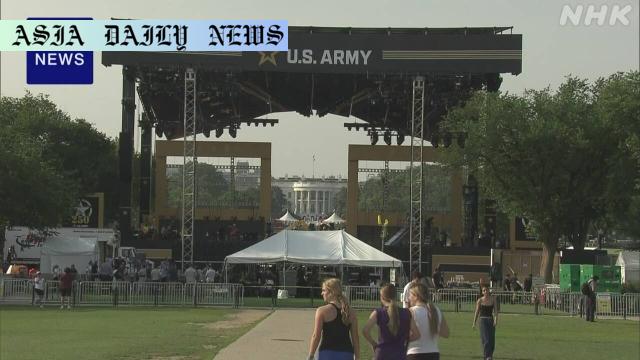Military Parade: The Trump administration plans a grand military parade in Washington DC for the US Army’s 250th anniversary.
The Trump administration will hold a military parade in Washington DC for the US Army’s 250th anniversary.
The event coincides with Trump’s 79th birthday and has drawn sharp criticism and protests nationwide.
Costing $4.5M, the parade includes 6,700 soldiers and 150 military vehicles such as Abrams tanks.
Protests titled ‘No Kings’ are being planned in over 2,000 locations throughout the United States.
Critics argue the parade misuses military resources and politicizes the armed forces.

The Trump Administration’s Grand Plan for a Military Parade
President Donald Trump’s administration has planned an elaborate and large-scale military parade in Washington DC, coinciding with two critical occasions: the 250th anniversary of the US Army and President Trump’s 79th birthday. Organized for Saturday evening, the event has already stirred nationwide discussion, attracting both fervent supporters and vehement critics. Although this celebration aims to honor the historical legacy of the US Army, its underlying implications and staggering costs have invited pointed criticism. The parade will begin at 6:30 p.m., covering a 1.4-kilometer stretch from near the Lincoln Memorial to the White House’s south side. Elaborate arrangements have been made, with US flags and banners embellishing the parade route and fences securing certain areas.
Visual Grandeur: Soldiers, Tanks, and National Pride
The military parade is slated to feature a massive visual spectacle, with 6,700 soldiers donning their uniforms and 150 state-of-the-art military vehicles, including the formidable Abrams tanks, set to move through Washington’s iconic streets. The defense-themed pageantry will serve as a tribute to one of the country’s longest-standing institutions while symbolizing strength and unity. However, this display has drawn comparisons to similar parades in authoritarian regimes, sparking concerns over their suitability in democracies such as the United States.
Financial and Political Concerns
The US Army has estimated the event’s cost at approximately $4.5 million, a figure that reflects the operational scope of this grandiose military showcase. Critics argue this expense constitutes a concerning misuse of resources, particularly given the pressing social and economic challenges the country faces. Additionally, many believe that the parade could be perceived as an attempt to politicize the US military by integrating it into partisan displays of power, a long-debated issue under the Trump administration.
Protests and Counter-Narratives
While the parade unfolds, it will not take place without dissent. Organized protests, branded as ‘No Kings,’ will occur in over 2,000 locations across the United States, emphasizing concerns over the erosion of democratic principles and accountability. These protests, which gained momentum amid actions like immigration raids and divisive rhetoric, indicate broader frustrations with President Trump’s leadership style and policies.
A Historical Context: Military Parades in Modern America
The Washington DC military parade marks the first such event since 1991, following the Gulf War when President George H. W. Bush organized a similar observance. While military parades have served as tools to bolster national pride in the past, the context is strikingly different today. Critics argue that analogous parades are often reflective of totalitarian or monarchical systems, rather than hallmarks of democratic nations like the United States.



Commentary
The Controversial Display of Military Power
President Trump’s decision to host a military parade to celebrate the US Army’s 250th anniversary has undeniably sparked a mix of admiration and critique. In a nation often divided by political leanings, such a highly visual and grandiose event risks further fracturing the line between patriotism and partisanship. For those who support the parade, it symbolizes national strength, pride, and the commendation of the military’s longstanding contributions to American history and security. However, critics raise valid concerns about the political optics and fiscal priorities of such a display in today’s socio-economic climate. When $4.5 million is earmarked for a single event, the public is left asking whether those funds could have been allocated toward other pressing issues such as public health, education, or infrastructure.
Protests and the Message of Resistance
The coinciding protests titled ‘No Kings’ highlight an important aspect of modern America: active citizen participation and dissent. The very fact that over 2,000 protests are being staged indicates widespread dissatisfaction with certain policies or governmental approaches under the Trump administration. These protests offer an essential counter-narrative to what some perceive as an excessive display of unilateral power. While military parades might foster national unity under certain conditions, in a polarized landscape, they can also ignite concerns of political opportunism and authoritarian undertones.
Balancing Celebration and Critique
The challenge with such events lies in balancing celebratory fervor with critical introspection. While commemorating the US Army remains a noble endeavor, it is equally vital to ensure that such a celebration upholds democratic values and inclusivity. History teaches us that public displays of military prowess can either unify or alienate, and it is incumbent upon leaders to tread this line carefully. With military parades last seen in the US over three decades ago, this revival of sorts might serve as an address to nostalgia, but it also comes with responsibilities and challenges too significant to be ignored.